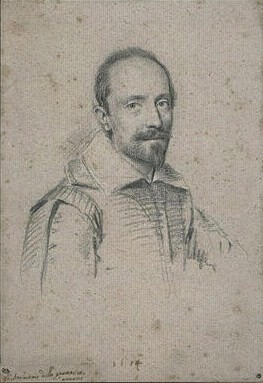Antiveduto Grammatica facts for kids
Antiveduto Grammatica (born 1571 – died April 1626) was an Italian painter. He was one of the first artists of the Baroque art style. Grammatica mostly worked near Rome.
Contents
Early Life and Training
Antiveduto Grammatica was born in 1571. He was born in either Siena or Rome. His father believed he would be born soon during a trip between Siena and Rome. Because of this, he was given the unusual name Antiveduto, which means "foreseen."
Antiveduto grew up in Rome. He also built his art career there. He learned to paint from an artist named Giovanni Domenico Angelini. Angelini taught him how to create small paintings, often on copper.
Grammatica became known for painting "heads of famous men." This special skill earned him the nickname "gran Capocciante." This means "great head painter." By 1591, Antiveduto was working as an independent artist.
Becoming a Master Painter
One of Grammatica's first important public paintings was for a church. It showed Christ the Saviour with St. Stanislaus of Krakow, St. Adalbert of Prague and St Hyacinth Odrowaz. He painted this for the main altar of Santo Stanislao dei Polacchi.
In 1593, Antiveduto joined the Accademia di San Luca. This was an important art academy in Rome. He became very close with two powerful leaders of the Academy, Cardinal Federico Borromeo and Cardinal Francesco Maria Del Monte. He was especially close to Cardinal Del Monte.
Because of his strong connections, Grammatica was chosen for the highest position at the Academy. In 1624, he became the "principe," or leader, of the Accademia di San Luca.
Challenges and Later Years
Soon after becoming "principe," Antiveduto faced a challenge. A valuable painting belonging to the Accademia was almost sold. This painting was believed to be by the famous artist Raphael. Cardinal Del Monte stepped in to help resolve the issue. He made sure the Academy's rules were followed.
Antiveduto Grammatica passed away in April 1626. This was just four months before his friend Cardinal Del Monte died.
Where to See His Art
You can find Antiveduto Grammatica's paintings in many museums around the world. Some of these include:
- The State Hermitage Museum in St Petersburg, Russia
- The Museo Nacional del Prado in Madrid, Spain
- The Kunsthistorisches Museum in Vienna, Austria
- The Muzeul Naţional Brukenthal in Sibiu, Romania
- The Kelvingrove Art Gallery and Museum in Glasgow, Scotland
- The Maison D’Art Gallery in Monaco
See Also
 In Spanish: Antiveduto Grammatica para niños
In Spanish: Antiveduto Grammatica para niños



